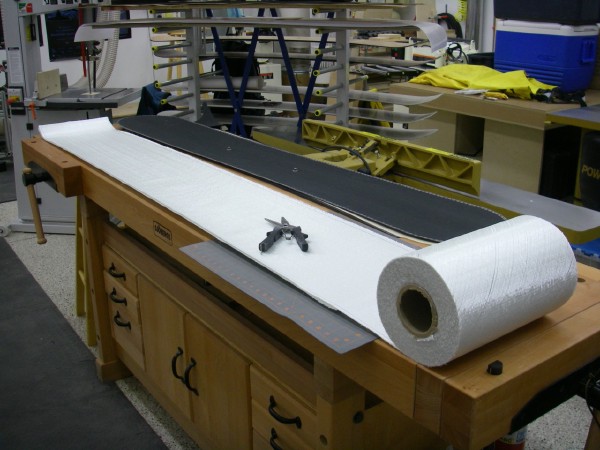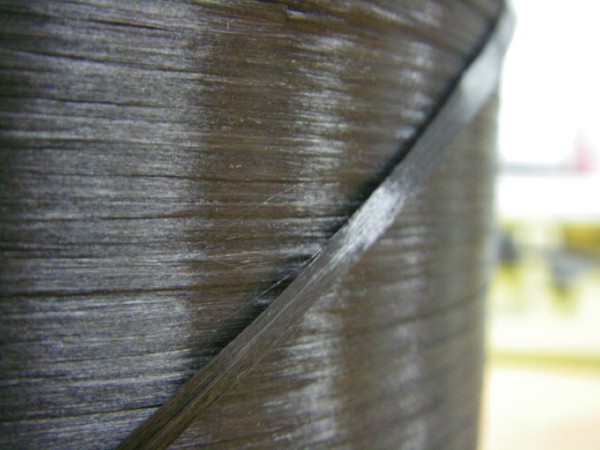Glass #

Stitched vs. Woven Fabrics #
I greatly prefer non-woven fabrics for snowboard and ski applications. Weaving causes stress points everyplace a bundle of fibers crosses over or under another bundle. The constant flexing of a snowboard causes a rapid breakdown of the resin around these stress points, leaving the fibers unsupported and thus prone to breaking. Boards built with woven fabrics lose their stiffness far more quickly than we find acceptable. Stitched fabrics allow the fibers of each layer to lay flat on top of each other yielding a stronger laminate over time. Further, stitched fabrics trap less resin than woven, resulting in a lighter laminate.
Vectorply has a good page on the differences between woven and stitched fabrics for these kinds of applications. Here’s a good summary from their page:
The crimping of yarns, inherent in weaving, causes stress points in the laminate and a subsequent knockdown in strength and stiffness. Pound for pound non-crimp reinforcements are 30% stronger than woven fabrics. Secondly, the coarse surface created by the weaving of fibers translates into poor shear properties because of less fiber-to-fiber contact. Third, the interstices created by the weave allow resin to pool amongst the rovings contributing to lower properties, adding unwanted weight and cost.
– Vectorply. (n.d.). Stitch-Bonded Reinforcements. Retrieved from http://vectorply.com/stitch-bonded-reinforcements/ on 2019/02/08.
Carbon and Kevlar #

Unidirectional Kevlar or carbon is used on some boards to provide extra stiffness and pop depending on the application. An especially large board might be reinforced with Kevlar strips along the base to help provide stiffness while keeping the core thinner, and thus reducing weight. Kevlar or carbon may be used in just the nose or tail section, or spread between the bindings and the nose or tail in order to give more torsional rigidity. I use 1” wide unidirectional Kevlar and carbon fiber, and in some applications many very thin strips of carbon roving.
Note: Unused KEVLAR® should be stored away from UV light. It will degrade in UV light.
Various fibers and reinforcements #
Fibers I’ve Used #
- Vectorply E-TLX 2200
- Vectorply E-TLX-1900
- Kevlar, biax, woven, 1.70 oz./yd.² (58 g/m²) Warp 34 Kevlar 49 195 Denier x Fill 34 Kevlar 49 195 Denier, Plain Weave, 3.0 mils (.08 mm) Thickness.
- Kevlar, unidirectional, heat set binder, 0.010" x 1", 6.8 oz./yd.².
- Carbon Fiber, unidirectional, heat set binder, 0.008" x 1", 5.3 oz./yd.².
- Carbon Fiber, unidirectional, 0.007" x 2.25", Hexcel HexForce GA045, 4.4 oz./yd.², 6k.
- Carbon Fiber, unidirectional, 0.010" x 12", Hexcel GA060, 6.7 oz./yd.² (227 g/m²), Warp 7 12K Carbon x Fill 4 Proprietary Heatset, Plain Weave, 10.1 mils (.26 mm) Thickness.
- Carbon Fiber, raw tow, roll from EBay long ago, Aomco Performance Products, Inc., P100-2K, grade 304-NT, 1.02lbs, 4800ft, 0.003-0.004" x ~3mm. 110 Msi, 348 ksi, 10 um filament diameter, 2880 denier / 3200 dtex (0.32 g/m).
Safety #
Glass, carbon, and Kevlar fibers are very small and easily penetrate your skin. They also float in the air and are easily inhaled, where they settle in your lungs. Wear gloves when handling the fibers. Wear a very high quality dust mask and goggles when cutting any of these materials, either raw or in a laminate. This is especially important when trimming the flash from a ski or snowboard, and when sanding the sides of the boards, as this generates a great deal of fiber-rich dust.